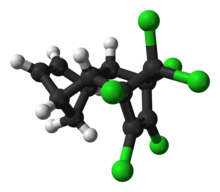
| |

| |
| Names | |
|---|---|
| Preferred IUPAC name
(1R,4S,4aS,5S,8R,8aR)-1,2,3,4,10,10-Hexachloro-1,4,4a,5,8,8a-hexahydro-1,4:5,8-dimethanonaphthalene | |
| Other names | |
| Identifiers | |
3D model (JSmol)
|
|
| ChEBI | |
| ChEMBL | |
| ChemSpider | |
| ECHA InfoCard | 100.005.652 |
| EC Number |
|
| KEGG | |
PubChem CID
|
|
| RTECS number |
|
| UNII | |
| UN number | 2762, 2761 |
CompTox Dashboard (EPA)
|
|
| |
| |
| Properties | |
| C12H8Cl6 | |
| Molar mass | 364.90 g·mol−1 |
| Appearance | Colorless solid |
| Density | 1.60 g/mL[1] |
| Melting point | 104 °C (219 °F; 377 K) |
| slightly soluble (0.003%)[1] | |
| Vapor pressure | 7.5 × 10−5 mmHg @ 20 °C |
| Pharmacology | |
| Legal status |
|
| Hazards | |
| Occupational safety and health (OHS/OSH): | |
Main hazards
|
Toxic and is a suspected human carcinogen[1] |
| GHS labelling: | |
  
| |
| Danger | |
| H300, H301, H310, H311, H351, H372, H410 | |
| P201, P202, P260, P262, P264, P270, P273, P280, P281, P301+P310, P302+P350, P302+P352, P308+P313, P310, P312, P314, P321, P322, P330, P361, P363, P391, P405, P501 | |
| NFPA 704 (fire diamond) | |
| Flash point | 66 °C (151 °F; 339 K) |
| Lethal dose or concentration (LD, LC): | |
LD50 (median dose)
|
50 mg/kg (rabbit, oral) 33 mg/kg (guinea pig, oral) 39 mg/kg (rat, oral) 44 mg/kg (mouse, oral)[2] |
LCLo (lowest published)
|
5.8 mg/m3 (rat, 4 hr)[2] |
| NIOSH (US health exposure limits): | |
PEL (Permissible)
|
TWA 0.25 mg/m3 [skin][1] |
REL (Recommended)
|
Ca TWA 0.25 mg/m3 [skin][1] |
IDLH (Immediate danger)
|
25 mg/m3[1] |
Except where otherwise noted, data are given for materials in their standard state (at 25 °C [77 °F], 100 kPa).
| |
Aldrin is an organochlorine insecticide that was widely used until the 1990s, when it was banned in most countries. Aldrin is a member of the so-called "classic organochlorines" (COC) group of pesticides. COCs enjoyed a very sharp rise in popularity during and after World War II. Other noteworthy examples of COCs include dieldrin and DDT.[3] After research showed that organochlorines can be highly toxic to the ecosystem through bioaccumulation, most were banned from use. Before the ban, it was heavily used as a pesticide to treat seed and soil. Aldrin and related "cyclodiene" pesticides (a term for pesticides derived from Hexachlorocyclopentadiene) became notorious as persistent organic pollutants.[4]
- ^ a b c d e f g h NIOSH Pocket Guide to Chemical Hazards. "#0016". National Institute for Occupational Safety and Health (NIOSH).
- ^ a b "Aldrin". Immediately Dangerous to Life or Health Concentrations (IDLH). National Institute for Occupational Safety and Health (NIOSH).
- ^ Zitko, Vladimir (2003), "Chlorinated Pesticides: Aldrin, DDT, Endrin, Dieldrin, Mirex", in Fiedler, H. (ed.), Persistent Organic Pollutants, The Handbook of Environmental Chemistry, vol. 3O, Springer Berlin Heidelberg, pp. 47–90, doi:10.1007/10751132_4, ISBN 9783540479321
- ^ Robert L. Metcalf "Insect Control" in Ullmann’s Encyclopedia of Industrial Chemistry" Wiley-VCH, Weinheim, 2002. doi:10.1002/14356007.a14_263
